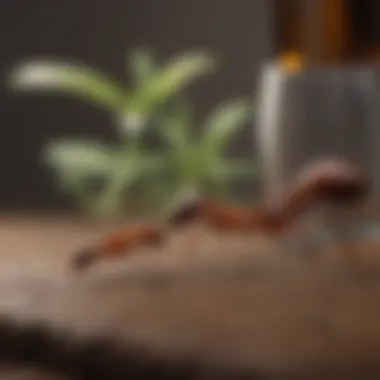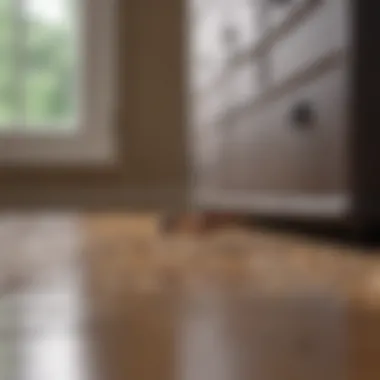Effective Strategies for Getting Rid of Ants in Your Home


Intro
Ant infestations can be frustrating for homeowners. Understanding the behaviors and habits of ants is crucial for effective removal. The effectiveness of various methods to get rid of ants hinges on identifying the specific species and understanding their environment. This article aims to provide a thorough guide on how to eliminate these pests from your home.
Animal Profile
General Overview
Ants belong to the family Formicidae, with over 12,000 identified species worldwide. These insects are social creatures, living in colonies that can consist of thousands, or even millions, of individuals. Their organized social structure makes them both fascinating and challenging to manage when they invade homes.
Habitat and Distribution
Ants are adaptable, finding habitats across diverse environments. They inhabit forests, deserts, grasslands, and urban settings. Inside homes, they often nest in walls, floors, and hidden corners. Some species, like the Carpenter ant, make nests in wood, while others, like the Odorous house ant, prefer damp areas.
Fascinating Facts
Unique Traits and Adaptations
Ants have evolved impressive traits that enable their survival. They can lift objects up to 50 times their body weight. Moreover, many ants communicate using pheromones, laying chemical trails to lead others to food sources. This communication plays a crucial role in how they forage and share information within their colonies.
Historical and Cultural Significance
Ants have fascinated humans for centuries. They often symbolize hard work and teamwork in various cultures. Ancient civilizations recognized their social structure and even documented their behaviors. In Japan, ants represent diligence in literature and folklore.
Control Strategies
Effective ant control requires a multi-pronged approach:
- Identify the species: Understanding the type of ant is key to choosing the right method for removal.
- Seal entry points: Inspect your home for cracks or holes and seal them to prevent access.
- Keep areas clean: Remove food sources by storing food in airtight containers and cleaning spills promptly.
- Natural remedies: Many homeowners prefer using vinegar, baking soda, or diatomaceous earth to deter ants.
- Professional services: In severe cases, contacting a pest control service may be necessary.
Properly addressing your ant problem can save significant time and hassle in the long run.
Epilogue
Understanding Ant Behavior
Understanding ant behavior is crucial for effective pest management. To successfully eliminate ants from your home, it’s important to grasp their habits, social structures, and environmental needs. This knowledge not only aids in identification but also informs targeted strategies for removal and prevention. Recognizing that different ant species have distinct behaviors enhances your ability to apply accurate control methods. Moreover, understanding what attracts ants to your environment can prevent future infestations.
Types of Ants Commonly Found Indoors
Indoor environments may host various ant species. Here are some common types:
- Carpenter Ants: These are large, black ants that can damage wooden structures. They make nests in moist or decaying wood.
- Odorous House Ants: Known for their distinct, rotten coconut smell when crushed, they often invade homes in search of sweet foods.
- Pavement Ants: Usually found outdoors, these small black or brown ants can enter homes while foraging for food.
- Pharaoh Ants: Small and light yellow, they thrive in warm conditions and are notorious for infesting buildings.
Knowing these ant types allows for better diagnosis and tailored responses to specific infestations.
Reasons for Ant Infestations
Ants invade homes for several reasons:
- Food Sources: Ants are primarily motivated by food. Crumbs, spills, and unsealed food items attract them easily.
- Nesting Sites: They seek out dark, warm places to build nests, which often leads them to kitchens and bathrooms.
- Moisture: Water sources can be a significant draw. Leaky pipes or damp basements create favorable conditions for their colonies.
Understanding these factors helps in adjusting one's environment to deter ants efficiently.
How Ants Navigate and Communicate


Ant navigation and communication are complex processes. Ants often use pheromones, chemical signals that influence behavior. When ants find food, they leave pheromone trails for others to follow. This is a key aspect of how colonies operate cohesively.
Additionally, ants can sense their surroundings through touch and smell. They often communicate through tactile interactions using their antennae. Recognizing these behaviors emphasizes the need for thorough and systematic approaches in detection and extermination.
Understanding the behavior of ants is essential for any effective ant control strategy. By recognizing what attracts them and how they communicate, you can effectively deter and eliminate these pests.
Identifying an Ant Infestation
Identifying an ant infestation is crucial for effective pest control. Understanding the signs of ants can save homeowners time and money. Diligent monitoring enables people to catch an infestation early, preventing larger problems down the line. By recognizing the issue swiftly, the chosen control method can be applied timely and effectively.
Signs of Ant Presence
Ants often leave telltale signs of their presence. These signs are crucial for early identification. Common indicators include:
- Trails: Ants often follow pheromone trails. Observing lines of ants moving to and from food sources is a clear sign.
- Nesting: Ants might create nests in walls, floors or under appliances. Seeing small piles of debris can indicate nesting sites.
- Food Markets: Any chewed packaging or discovered food remnants indicate food sources that need addressing.
- Droppings: Some species leave tiny specks as droppings. Noticing these specks requires a close look.
Recognizing these signs early helps in managing the situation effectively. Ignoring them may allow the problem to grow.
Common Entry Points for Ants
Ants are resourceful pests. Identifying where they enter your home is vital in preventing future infestations. Common entry points include:
- Cracks and Gaps: Small openings around walls and foundations often go unnoticed. These allow ants easy access indoors.
- Windows and Doors: Poor sealing around windows and doors can attract ants searching for food.
- Utility Lines: Ants sometimes enter through openings made for plumbing or electrical lines.
By securing these points, the chance of infestation decreases significantly. A thorough inspection will aid in finding these areas and sealing them properly.
Assessing the Severity of Infestation
Understanding how severe an infestation is can guide your response strategy. To assess the severity:
- Monitoring Activity: Count the number of ants observed in a given area. A few ants might mean an isolated incident, while many suggest a larger problem.
- Inspecting Nest Locations: Find where ants are nesting. If nests are located indoors, the problem may require urgent attention.
- Evaluating Damage: Check for structural damage caused by ants. This includes wood damage and other signs of prolonged presence.
Summarizing the severity brings clarity to the situation. It helps choose either DIY methods or professional help for control, suiting the problem’s scale.
Understanding the signs and entry points allows for more strategic actions. Early intervention is key.
Preventive Measures
Preventive measures play a critical role in controlling ant infestations before they escalate into more significant problems. By understanding why and how ants enter your home, you can implement effective strategies that not only reduce the chances of an infestation but also create a more comfortable and hygienic living environment. Ants can quickly establish colonies, thus knowing how to mitigate risks is essential.
Maintaining Cleanliness in Your Home
Keeping your home clean is perhaps the most basic yet effective strategy to deter ants. Regularly sweeping and vacuuming floors can remove food particles that attract these pests. Pay special attention to the kitchen and dining areas, as crumbs are often a major draw for ants. Frequent spills should be cleaned immediately, and trash areas must be kept sanitized.
- Empty garbage bins often.
- Store cleaning supplies in a tidy manner.
- Wash dishes promptly.
Additionally, decluttering your living space can make it less appealing for ants. Clutter can provide both shelter and food sources for the ants, enabling them to thrive. Thus, reducing any unnecessary items that collect dust and food residue can significantly lower the risk of ant activity in your home.
Sealing Entry Points
Another important preventive measure is sealing entry points around your home. Ants are small and can find their way through tiny cracks and crevices. Inspect your home’s exterior, particularly areas around pipes, windows, and doors. Use caulk or sealant to close any gaps you find. Pay careful attention to areas of high moisture, as these could beckon ants seeking water.
- Caulk gaps around doors and windows.
- Use weather stripping to improve door seals.
- Repair any leaks in plumbing to eliminate moisture.
Taking these steps can greatly minimize the likelihood of ants entering your space. It is advisable to regularly check these areas, as wear and tear can create new access points over time.


Storing Food Properly
Proper food storage is essential in thwarting ant attractants. Food items, both sealed and unsealed, can entice ants into your home. To mitigate this risk, store food in airtight containers. Using glass or plastic containers with tight-fitting lids is effective. Additionally, it is vital to keep pet food covered and to limit its open time to reduce food exposure.
- Store pantry items in sealed containers.
- Refrigerate perishable items promptly.
- Clean up after meals and snacks to remove food traces.
By implementing these food storage techniques, you reduce the availability of food sources for ants, making your home less appealing to them. It's a simple yet crucial step in preventing an ant invasion.
Remember, a proactive approach will always be more effective than reactive measures when dealing with pest control. Maintaining a clean environment, sealing entry points, and storing food properly not only helps in getting rid of ants but also keeps other pests at bay.
Natural Remedies for Ant Control
Natural remedies are essential in the fight against ants in homes. These methods provide a sustainable approach to pest management, helping to control infestations without relying on harsh chemicals. Many homeowners prefer these alternatives due to their effectiveness and safety for both humans and pets. By utilizing natural remedies, you not only address the existing ant problem but also reduce the risk of future infestations.
Using Vinegar and Water Solution
A simple yet effective solution for getting rid of ants is a vinegar and water mixture. This remedy leverages the strong scent of vinegar, which disrupts the ants' pheromone trails. Ants use these trails to navigate, and removing them makes it difficult for them to find food and return to their nests.
To create this solution, mix equal parts of water and vinegar in a spray bottle. Here’s how to use it:
- Identify ant trails and nests in your home.
- Spray the solution directly onto the ants and infested areas.
- Wipe up the remaining mixture to eliminate any residual scent.
This method is best used regularly, particularly in places where you frequently see ants. The solution is non-toxic and safe to use around children and pets.
Essential Oils for Deterrence
Essential oils serve as a powerful deterrent for ants. Their strong aromas are unappealing to many species, making them an excellent choice for keeping ants away. Oils such as peppermint, tea tree, and citrus are particularly effective.
To use essential oils for ant control, follow these steps:
- Add 10-15 drops of essential oil to a spray bottle filled with water.
- Shake well to ensure proper mixing.
- Spray the solution in areas where you have noticed ant activity, focusing on entry points and trails.
Using essential oils not only helps to repel ants but also leaves your home smelling fresh. Regular application can create an environment that ants find inhospitable, discouraging them from entering.
Diatomaceous Earth as a Natural Barrier
Diatomaceous earth is another effective natural remedy for ant control. This powdery substance is made from the fossilized remains of tiny aquatic organisms known as diatoms. It is non-toxic to humans and pets while being lethal to insects, including ants.
To deploy diatomaceous earth:
- Sprinkle a thin layer on surfaces where ants are seen, especially near entry points.
- Ensure the area remains dry, as moisture reduces its effectiveness.
- Leave the powder in place, allowing ants to come into contact with it.
As ants walk through the powder, it damages their exoskeleton, leading to dehydration and death. This method is long-lasting and can provide ongoing protection against future infestations.
By employing these natural remedies, homeowners can effectively control and prevent ant infestations. Each method offers unique benefits and ensures a safe environment free from harmful chemicals.
Chemical Solutions for Ant Removal
Chemical solutions play a significant role in the effective removal of ants from homes. These methods are often faster than natural alternatives and can target specific ant species. Understanding the various options available is crucial for homeowners struggling with infestations. This section will cover commercial ant baits, insecticides, and the circumstances under which professional extermination might be the most viable course of action.
Types of Commercial Ant Baits
When addressing an ant problem, commercial ant baits are among the most popular choices. They are designed to attract ants and contain slow-acting poisons that the ants carry back to their colonies. This method effectively eliminates the entire colony rather than just the visible ants. Some common types of commercial ant baits include:
- Gel Baits: These are typically composed of a thick gel containing a toxicant. They are ideal for indoor use, as they can be placed in hard-to-reach areas where ants forage.
- Liquid Baits: Liquid baits are similar to gel baits but in a liquid form. They often come with a small plastic dish or container for easy placement.
- Granular Baits: These bait types are in a solid form, usually designed for use outdoors. The granules are spread around the perimeter of the home where ants may enter.


The choice of bait depends on the specific needs and circumstances of each infestation. It is essential to read the labels carefully to ensure effective use.
Insecticides: Application and Safety
Insecticides provide another chemical solution for ant control. However, they should be used with caution. Proper application is critical to minimize risks to humans and pets. Here are some important points to consider when using insecticides:
- Choosing the Right Product: Not all insecticides target ants specifically. Selecting a product labeled for ant control ensures better results.
- Application Method: Insecticides can come in sprays, powders, or granules. Spraying is effective for immediate kill, while powders may provide a long-lasting barrier against future infestations. Always follow the manufacturer’s guidelines.
- Safety Precautions: When applying insecticides, use gloves and a mask to protect against inhalation or skin contact. Ensure that children or pets are kept away during application.
- Avoid Indoor Use When Possible: Chemicals can linger in indoor environments. It's often better to use baits for indoor problems while reserving sprays for exterior treatments.
When to Consider Professional Extermination
While DIY methods can be effective, they are not always sufficient. In some cases, it is better to consult professionals. Here are a few indicators that it may be time to consider professional extermination:
- Persistent Infestation: If the ant problem persists despite repeated efforts with baits and insecticides, this suggests a larger infestation.
- Identification of Carpenter Ants: These ants can cause structural damage to homes. Their presence is a serious concern that warrants professional intervention.
- Health Risks: If infestations are impacting health, such as causing allergic reactions, seeking expert help is essential.
- Insufficient Knowledge of Products: Homeowners unsure about which products to use or concerned about applying them safely may prefer to hire professionals.
Taking these factors into account can save time and effort while ensuring a swift resolution to ant problems in the home.
Chemical solutions offer immediate and targeted control of ant populations but must be applied carefully and thoughtfully. Engage a professional when in doubt or faced with persistent issues.
Long-term Solutions to Prevent Resurgence
Maintaining a home free of ants requires a strategy that goes beyond immediate solutions. Long-term solutions focus on sustained prevention and proactive measures. These approaches not only reduce the risk of re-infestation but also foster an environment where ants are less likely to thrive. Understanding that addressing the root causes is crucial is key to effective pest management.
Monitoring and Regular Inspections
Regular monitoring is essential to ensuring that your home remains ant-free. This involves not just looking for ants but also examining potential nests and paths they may use. Checking common areas such as kitchens, basements, and entryways can help identify vulnerabilities.
- Establish a routine: Conduct monthly inspections during peak ant activity seasons.
- Use tracking methods: Place bait stations in strategic areas to see if ants are still active.
- Log findings: Maintain a record of sightings and conditions that may attract ants.
By keeping a consistent check on your home, you can catch problems early and act before they escalate.
Educating Family Members About Ant Control
A united household approach to ant control is vital in sustaining success. All family members should understand the importance of cleanliness and observation. Educating them about how ants behave and what attracts them to the home is essential.
- Identify problem areas: Show family members where to look for signs of ants.
- Discuss cleanliness: Emphasize the importance of cleaning up food scraps and spills promptly.
- Provide guidelines: Create actionable steps that everyone can take to help in prevention.
When everyone understands their role, it leads to more effective control measures both in the short and long term.
Creating an Integrated Pest Management Plan
An Integrated Pest Management (IPM) plan combines various strategies for a comprehensive approach. It focuses on prevention, monitoring, and control, utilizing both natural and chemical methods as needed.
- Assess risks: Identify areas prone to ant activity.
- Select appropriate preventive measures: Choose methods based on the severity of the problem, whether that involves sealing cracks, using baits, or maintaining cleanliness.
- Review and adjust: Periodically evaluate the effectiveness of your plan and make necessary adjustments based on observations.
An IPM approach not only manages pests effectively but also reduces reliance on chemical treatments, which is beneficial for both health and the environment.
Focusing on these long-term solutions will help ensure that your home remains free from ants for the future. By monitoring regularly, educating the household, and constructing a solid management plan, you set a strong foundation for ongoing ant prevention.
Ending
Dealing with ants in your house is not just a minor inconvenience. It can escalate into a significant issue if not addressed properly. Understanding the complexity of ant behavior, their attraction to domestic environments, is crucial. This article has covered various aspects, from identifying an ant infestation to natural remedies and chemical solutions.
Summary of Key Points
In summary, several essential points emerge from this guide:
- Ant Behavior: Knowing the types of ants and their habits facilitates better management strategies.
- Signs of Infestation: Detecting the signs early can prevent a more severe problem.
- Preventive Measures: Consistent cleanliness and sealing entry points can significantly reduce ant invasions.
- Control Techniques: A combination of natural and chemical methods is often necessary.
- Long-term Strategies: Regular monitoring and education are key to preventing future infestations.
Final Thoughts on Ant Management
The management of ants requires a diligent and multifaceted approach. It is paramount to address not only the visible problem but also the underlying causes. Employing various methods enhances the likelihood of success. Balancing preventive measures and active control will create a sustainable ant-free environment. By following these strategies, individuals can reclaim their living spaces effectively and ensure long-lasting results.















